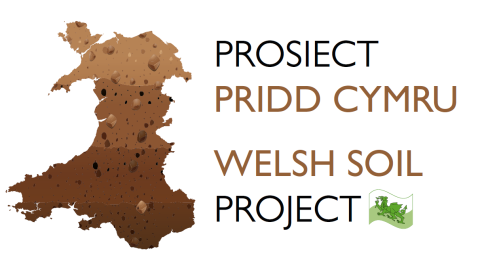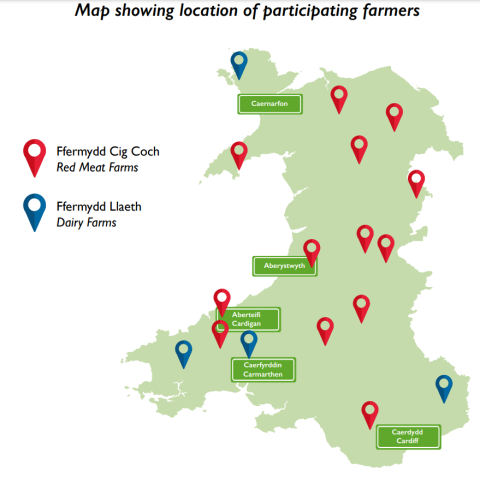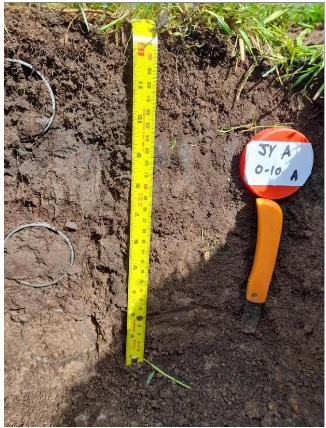Farming Connect Demonstration Network - Welsh Soil Project
The Welsh Government is committed to reaching net zero emissions by 2050 It is recognised that every sector, including agriculture, has a role to play in reducing the production of greenhouse gas emissions. However, farming systems also have the capability to sequester carbon from the atmosphere.
Soils may be carbon sinks or sources depending on a number of factors, such as land use, management practices, climate and soil type. Changes in soil carbon stock occurs gradually over several years, and accumulation over time will reach an equilibrium. Quantifying a common baseline in soil carbon stocks is a challenge due to this. Nevertheless, quantifying and understanding soil carbon stocks has gained significant interest within the agricultural sector in recent years.
Detailed measurement and monitoring of carbon content within soils provide useful figures for benchmarking by assessing soil carbon levels in the future. Also, to understand the importance of managing soils in a manner that will have a positive impact on soil health, microbial activity, nutrient supply and crop yield.
Farming Connects demonstration network consists of cross-sector demonstration sites (Figure 1) that vary in their farming systems, location, climate and soil type. The project will be replicated across all demonstration sites to provide a database from different farms.
Figure 1. Map showing participating farmers
The project objectives will be as follows:
- Carry out a soil carbon audit on a proportion of the farm’s fields (fields that vary in their soil type/properties and use/management)
- Assess soil microbial activity by burying cotton material and evaluating its decomposition over time
The project will determine the soil carbon stock of multiple fields from varying farming systems. In doing so, the aim is to provide an insight into carbon sequestration potential and current soil health as a result of differences in soil types and properties, as well as land use and management.
Field work
Each Farming Connect Technical Officer had identified five varying fields to be sampled for the project with the Farmer prior to sampling. The fields selected for sampling should fit into the following categories:
- Permanent pasture field (>7 years)
- Silage and/or hay field
- A field that was recently reseeded (1-7 years)
- Grazing only field
- Other – arable (if there is an arable field on the farm). If not, any other different field type selected at the farmer’s discretion (e.g. peatland, herbal ley, stock excluded)
Detailed information on soil type, properties and management history, including land use and nutrient inputs was recorded via a questionnaire completed by the Technical Officer with the Demonstration Farmer prior to sampling.
Soil samples (composite and bulk density) were taken from three zones within each field, See figure 2. This provides information on the spatial variability in soil carbon content across the field. The composite soil samples were analysed for Soil Organic Matter (SOM) content (%). The results were used to calculate Soil Organic Carbon (SOC) content (%), which is a component of SOM. The samples were also analysed for Total Carbon (C) (%) and Total Nitrogen (N) (%) content, from which the C:N ratio and Soil Inorganic Carbon (SIC) content % can be calculated. The bulk density cores were taken to provide information on soil compaction and to calculate total carbon stock (tonnes/ha).
At each sampling point three depths will be extracted, 0-10cm, 10cm-30cm, 30cm-50cm and were mixed together to provide a composite sample for each depth. In regards to the Bulk Density sample a stratified random sampling was implemented within each zone, represented by the yellow dot in figure 1, with samples being collected via a Bulk density ring at the three depths (Figure 3)
Figure 2. Each field split into three zone. Within each zone a soil samples are collected in a W format with the yellow dot representing the location of the bulk density sample.
Figure 3. Bulk Density sampling method.
Laboratory work
Organic matter content
The mixed soil cores collected using the soil corer were sent directly to NRM Laboratories to be analysed for SOM content via the loss on ignition method.
The results, were used to estimate the SOC content (%) of each sample (which is a component of SOM).
Total Carbon and Total Nitrogen
The mixed soil cores were used to calculate the Total C and Total N content (%) of each sample by NRM Laboratories, which are expressed as C:N ratio. This analysis was undertaken via the Dumas combustion method.
Soil bulk density
The soil bulk density samples taken using the rings were analysed in-house, following this protocol:
Soil volume = BD ring volume (known)
- Weigh an ovenproof container in grams
- Remove the wet soil core from the sampling bag and weigh
- Dry the soil in a conventional oven at 105°C for 16 hours
- Re-weigh the dried core on the scales
- Grind the core in the pestle and mortar to break down the structure
- Sieve the sample (<2mm) to remove and weigh stones
- Deduct stones weight from the fresh weight and dry weight to give correct fresh weight and dry weight
- Dry soil weight (g) = fresh weight – dry weight
- Calculate bulk density (g/cm3) using the following equation = Dry soil weight (g) / Soil volume (cm3)
The BD results were used along with the SOC results to calculate the carbon stock (tonnes/hectare).



